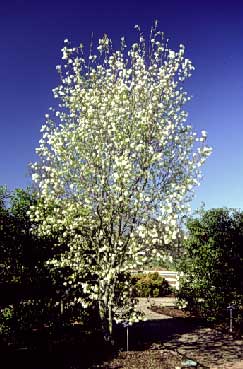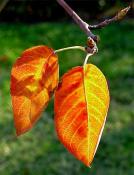Owing to the screen size of your device, you may obtain a better viewing experience by
rotating your device a quarter-turn (to get the so-called "panorama" screen view).
|
This page updated for 2022.
|
Click here for the site directory.
|
|
Please consider linking to this site!
|
Click here to email us.
|
Serviceberries
(Amelanchier sp.)
About Serviceberries

The Serviceberry—also widely know as (among many other names) Juneberry, saskatoon, sarvisberry, mespilus, sarvis, shad-blossom, shadwood, shadblow, shadbush, sugarplum, wild-plum, and chuckley pear—has a good taste and is certainly hardy here. But, as with other fruit plants, while the plant may be hardy, it does not follow as the night the day that the fruit will survive freezes; we thus prefer types that flower later then the average. Fortunately, as serviceberries have become better known and more popular, named cultivars, and information about them, are now much more available than was the case only a few years ago.
All of those names refer to related but slightly different plants: the genus is Amelanchier, but it comprises about 20 distinct species. But for berry-growing purposes, we can just lump the lot as serviceberries (or whatever other handle you choose to call them by).
Serviceberry Cultivars
Of the many cultivars, two that seem to emerge as late-flowering types with excellent fruit quality and wide availability are:
- Northline, and
- Honeywood.
Though the plants are self-fertile, we’d put in one of each, just to cover all the bases.
Note that by proper pruning and training, a serviceberry “bush” can be made to look very much like a fair-sized tree, and that is why we list the berry here, with fruit trees, rather than with berry bushes. (See the image above on the right.)

By the way: why the heck isn’t this guy even better known? Not only does he produce delicious edible fruit, he is hardy from Zones 3 to 9, he reportedly makes superb fall foliage (many people put them in just for their decorative value—see image at left), is very drought-tolerant, is compact (circa 10 to 15 feet high) but so sturdy that he makes, and is commonly used for, an excellent windbreak, and is even self-fertile! America, what are you missing here? (Canada knows and loves it.) One problem may be that people who know the plant from landscape use may not realize that not all cultivars taste the same, by any means: though all the berries are edible, only those from species reckoned as food types will have the superior taste associated with this fruit.
Planting and Growing
Plan on putting your serviceberry seedling plants into the ground in late spring or early summer, say June. Set them in a full-sun location, keep them well watered, and consider some high-phosphate fertilizer.
Important! If you don’t protect your serviceberry bushes/trees from pests, you will get little if any fruit—and that protection starts as you plant them. Refer to the protection notes on the main “fruits” page of this site for details.
Have patience: serviceberries show very little visible growth in their first year. But they should begin to flower and bear fruit in 3 to 4 years. They should reach peak production in 8 to 10 years, after which they will probably outlive you.
More
Relevant Links
Besides any links presented above on this page, the following ought to be especially helpful:
(And don’t forget that we have listings of nurseries on our suppliers page.)
Odds and Ends
Biology
This is yet another of the highly useful fruits from the Rosaceae family, which supplies us with so much of our fruit and berries.
History
The plant is native in both the Old and New Worlds; it was a valued foodstuff of the native inhabitants of North America, who used it to (among other things) flavor the staple food mix pemmican.
Envoi
The preferred name “serviceberry” derives from the similarity of the fruit of this bush to that of the related European “service tree” (Sorbus domestica), a name that came in turn from the French sorbier, which is from the Latin name for the tree, sorbus, a usage mentioned by Pliny the Elder.
Return to the top of this page.
If you find this site interesting or useful, please link to it on your site by cutting and pasting this HTML:
The <a href="https://growingtaste.com/"><b>Growing Taste</b></a> Vegetable-Gardening Site
—Site Directory—
Search this site, or the web
-
Background Information
about the purposes and design of this site
- Site Front Page
-
Introduction

- An Apologia: why one should cultivate one's garden
- Deep-Bed Gardening (forthcoming)
- Container Gardening (forthcoming)
- Vegetarian and Organic Considerations (forthcoming)
-
Recommended Crops for a home garden, by variety
-
Gardening information and aids
-
Miscellaneous Information of interest to the home gardener
Since you're growing your own vegetables and fruits, shouldn't you be cooking them in the best way possible?
Visit The Induction Site to find out what that best way is!
|
If you like good-tasting food, perhaps you are interested in good-tasting wines as well?
Visit That Useful Wine Site for advice and recommendations for both novices and experts.
|

|
This site is one of The Owlcroft Company family of web sites. Please click on the link (or the owl)
to see a menu of our other diverse user-friendly, helpful sites.
|
|
 Like all our sites, this one is hosted at the highly regarded Pair Networks,
whom we strongly recommend. We invite you to click on the Pair link for more information on getting your site or sites hosted on a first-class service.
Like all our sites, this one is hosted at the highly regarded Pair Networks,
whom we strongly recommend. We invite you to click on the Pair link for more information on getting your site or sites hosted on a first-class service.
|
|
All Owlcroft systems run on Ubuntu Linux and we heartily recommend it to everyone—click on the link for more information.
|
Click here to send us email.
Because we believe in inter-operability, we have taken the trouble to assure that
this web page is 100% compliant with the World Wide Web Consortium's
XHTML Protocol v1.0 (Transitional).
You can click on the logo below to test this page!
You loaded this page on
Friday, 18 April 2025, at 21:40 EDT.
It was last modified on Monday, 24 January 2022, at 08:14 EST.
All content copyright ©1999 - 2025 by
The Owlcroft Company


